www.andyfilm.com
Message Board (open 24 hours!)
Twitter - @andredursin (for everything else!)
Late in August of 1990, William Peter Blatty’s anticipated THE EXORCIST III (110 mins., R; Shout! Factory) arrived in theaters. The Morgan Creek production, released by Fox, drew strong initial interest from audiences – and even a few positive reviews – before crashing quickly in the dumping grounds of late summer. Now a cult favorite, Blatty’s own adaptation of his novel “Legion” was resurrected as a 2016 Scream Factory Collector’s Edition, complete with a reconstruction – from the best surviving sources – of Blatty’s initial cut of the film, finished before anxious studio executives mandated a punchier, effects-laden conclusion be shot. That package is now on 4K UHD with a sizzling new remaster of the theatrical version, presented with Dolby Vision HDR.
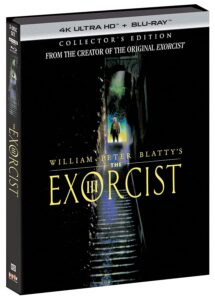 George C. Scott stars in the film as Lt. Kinderman, the Washington, D.C. cop played by Lee J. Cobb in the 1973 William Friedkin classic. Here tasked with solving a series of grizzly murders carrying an increasingly religious connotation, Kinderman’s investigation includes both the death of his beloved friend Father Dyer (Ed Flanders, in funny scenes that make you wish he and Scott had more screen time together) and the strange presence of “Patient X” (Brad Dourif) – a hospital inmate who claims he’s the “Gemini Killer.” The only problem is that psycho died some 15 years before, on the same night the demon claimed the life of Father Karras (Jason Miller) in the Regan MacNeil exorcism… George C. Scott stars in the film as Lt. Kinderman, the Washington, D.C. cop played by Lee J. Cobb in the 1973 William Friedkin classic. Here tasked with solving a series of grizzly murders carrying an increasingly religious connotation, Kinderman’s investigation includes both the death of his beloved friend Father Dyer (Ed Flanders, in funny scenes that make you wish he and Scott had more screen time together) and the strange presence of “Patient X” (Brad Dourif) – a hospital inmate who claims he’s the “Gemini Killer.” The only problem is that psycho died some 15 years before, on the same night the demon claimed the life of Father Karras (Jason Miller) in the Regan MacNeil exorcism…
Part psychological thriller, part supernatural chiller, “The Exorcist III” largely bypasses the shock effects of the 1973 film in favor of a moody, weird, off-kilter picture heavy on atmosphere and sound design. Blatty accentuates creaking floors, blowing winds, words muttered in whispers and the power of suggestion for the film’s first half, making for an intelligent and uneasy mystery that connects intriguingly with the original film. Individual moments linger long after the film has concluded (Kinderman’s dream sequence; an elderly hospital patient crawling on the ceiling!), making for a film that’s endlessly repeatable and superbly performed by Scott, Dourif and Blatty’s repertory company (Miller, Flanders, Scott Wilson).
Unfortunately for Blatty, Morgan Creek and Fox executives were horrified when they saw the first version of the picture, which – to be fair – fizzled out after a strong start. Thinking audiences needed to actually see an exorcism, a hefty sum was spent on extensive new shooting, bringing along scores of special effects artists and the participation of both Jason Miller – reprising Father Karras – and Nicol Williamson, who were added to the cast in post-production reshoots that, by all accounts, were problematic to produce. And, admittedly, the subsequent, ultimate transition between the subtle and the explicit was always a little bit jarring in “The Exorcist III,” as the film’s most effective passages – like that long shot down the hospital corridor, showing a nurse checking in and out of various rooms – were comparatively low-key.
Yet if there’s anything Shout’s Blu-Ray confirms, it’s that those restless executives were onto something. The “Legion” Director’s Cut (104 mins.) of “The Exorcist III” illustrates that the tinkering was, in fact, necessary, as Blatty’s original version promises more than it actually delivers.
The main difference between the two cuts lies in Brad Dourif’s performance. Dourif was cast to play both “Patient X” as well as Father Karras, with the film establishing Dourif via photographs as the protagonist of the first film. The problem, though, is that Dourif was neither Jason Miller nor did Blatty really dive into the suggestion that Father Karras was, somehow, buried inside the man claiming to be the Gemini Killer. The reshoots clarified and further developed that notion, and the casting of Miller himself added a major component lacking from Blatty’s cut. It’s not a knock on Dourif – whose performance in the Director’s Cut is subtler and may have been altogether creepier – but the overriding story is crystalized in the theatrical version to palpable dramatic effect.
More over, all the razzle dazzle of the reshoots actually provided the film a climax that’s also absent in Blatty’s version. What begins as a tantalizing mystery turns into a frustrating, and emotionally chilly, thriller that abruptly ends on a major down note in Blatty’s cut. There’s just no pay off, nothing to justify the build-up, in what Blatty originally produced, making one conclude that what may have worked fine on the printed page needed the proverbial “more” en route to the screen.
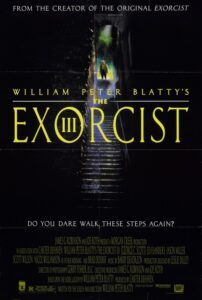 Shout’s 4K UHD carries over its 2016 supplemental package, which boasted then-new interviews with surviving cast/crew members, including Brad Dourif, producer Carter DeHaven, production designer Leslie Dilley, loads of make-up artists, bit players in the supporting cast, and composer Barry DeVorzon among others. Editor Todd Ramsay relays several fascinating tidbits, including the revelation that he knew he was sitting with Blatty for the final time when he unspooled his edit of the film – to negative reaction from seemingly everyone involved, except Dourif, who thinks his performance was much better in Blatty’s version. Meanwhile, DeVorzon’s talk implies studio brass didn’t like his score either – with even Carter DeHaven seemingly unenthusiastic over his initial hiring – which is no shock since there’s less music in the film than there is sound design (though in that regard, DeVorzon’s work was ahead of its time). Shout’s 4K UHD carries over its 2016 supplemental package, which boasted then-new interviews with surviving cast/crew members, including Brad Dourif, producer Carter DeHaven, production designer Leslie Dilley, loads of make-up artists, bit players in the supporting cast, and composer Barry DeVorzon among others. Editor Todd Ramsay relays several fascinating tidbits, including the revelation that he knew he was sitting with Blatty for the final time when he unspooled his edit of the film – to negative reaction from seemingly everyone involved, except Dourif, who thinks his performance was much better in Blatty’s version. Meanwhile, DeVorzon’s talk implies studio brass didn’t like his score either – with even Carter DeHaven seemingly unenthusiastic over his initial hiring – which is no shock since there’s less music in the film than there is sound design (though in that regard, DeVorzon’s work was ahead of its time).
The interviews are all candid and interesting, and a full-length commentary (dubbed an audio interview) between Blatty and Michael Felsher is wide-ranging and accompanies the Director’s Cut itself. There are also vintage EPK materials sporting interviews with the likes of Scott, Blatty, and Larry King (who has a cameo along with Samuel L. Jackson, C. Everett Koop and Fabio!), plus trailers and TV spots, several of which carry unused FX shots. A few minutes of deleted scenes/bloopers are on-hand as well, including a discarded prologue taken from film elements (albeit in black-and-white).
Most of “Legion”’s specific alternate/added materials, however, are derived from VHS dailies – all that remains of Blatty’s first version of the picture. With that being considered, Shout has painstakingly assembled his “Legion” in a 104-minute reconstruction that varies between HD footage from the theatrical version and 1.33-based videotape material. It’s unfortunate that the original materials couldn’t be found, but Shout did the best job possible with what they had to work with, and I’d imagine this cut will likely rank as just a curiosity for many to begin with.
In Shout’s new UHD/Blu-Ray Collector’s Edition, the theatrical version has been remastered in a new 4K scan (1.85) and this is a great enhancement to the previous Blu-Ray edition; even better, not only is this remaster offered here on UHD but on a new Blu-Ray, enclosed in this package, as well.
Fans will get the most mileage, obviously, out of the UHD presentation. With Dolby Vision HDR grading, the image manages to be more layered in its contrast levels than its previous HD master, which enhances the contribution of DP Gerry Fisher (the older presentation seems excessively bright and bland by comparison now). Colors are a little warmer and detail seems more transparent – meanwhile, on the audio end, Shout has, at last, brought over the original Dolby Stereo soundtrack in a 2.0 DTS MA container that fans are sure to appreciate.
When “The Exorcist III” transitioned from Fox over to Warner Bros. (Morgan Creek’s last studio home), the movie’s original stereo audio was remixed into a muddy 5.1 track that was, in short, an unmitigated disaster. Left/right separation and surround activity were all, inexplicably, fed into the center channel instead, making for a botched 5.1 track that’s all viewers were able to experience throughout the DVD and Blu-Ray era (unless you had access to Arrow’s UK Blu-Ray, which was the first to restore it). The good news is that original 2.0 mix is back here on UHD and a remastered Blu-Ray which is derived from the same 4K scan, offering discrete channel effects and surround activity – all increasing the creepy mood of the film.
We’ve been seeing numerous 4K catalog titles this year and while a few have missed the mark, Shout’s “Exorcist III” UHD is must for horror buffs and an appreciable upgrade of Blatty’s personal “Exorcist” sequel – one that has weathered the years better than its unholy counterparts.
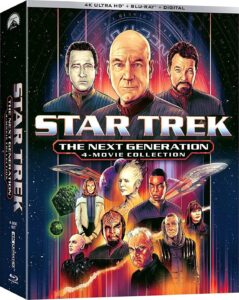 Also New on 4K UHD Also New on 4K UHD
Fresh 4K scans with Dolby Vision HDR will provide Star Trek fans with a reason to revisit Captain Picard and company in Paramount’s new STAR TREK: THE NEXT GENERATION – 4-MOVIE COLLECTION, sporting the quartet of films featuring the TNG crew, produced between 1994-2003. Since the respective Blu-Rays of the initial three films in this cycle were doused with DNR, these are substantial upgrades from a transfer perspective and, unquestionably, come highly recommended for fans.
The TNG cast’s big-screen debut came with STAR TREK: GENERATIONS (117 mins., 1994, PG), which intended to launch the TNG cast on their own big-screen adventures at the same time it bridged the gap with the original series. Somehow or other, though, I always envisioned Captain Kirk going out with more of a bang than being beaten up by Malcolm McDowell’s forgettable bad guy on the top of a giant rock. That’s one of the major problems with this uneven, occasionally tedious but still sporadically entertaining film, which works best when Shatner and Patrick Stewart’s Captain Picard share the spotlight in the film’s concluding minutes.
Up until that point, screenwriters Ron Moore and Brannon Braga spend too much time on scientific mumbo-jumbo, a murky plot involving “The Nexus” (didn’t “Star Trek V” already handle the mystical Eden at the end of the galaxy?), and supporting players who walk around without a whole lot to do. The movie — as evidenced by the supplementary features included here – was obviously treated with kid gloves by the studio, which viewed “Generations” as a major property and launching pad for future “Next Gen” movies, and David Carson’s film feels more “safe” than inspired as a result.
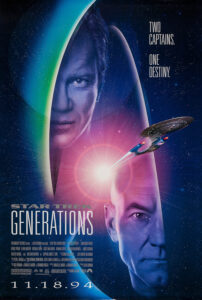 What a shame, too, since the movie has some excellent moments, sparkling cinematography by John A. Alonzo, and an excellent score by Dennis McCarthy which I felt was unfairly maligned by some fans upon its initial release. Years later, McCarthy’s score has held up even better than I thought it would, with the composer offering a fresh slate of themes and a more majestic, ethereal sort of score than the later TNG films contained. What a shame, too, since the movie has some excellent moments, sparkling cinematography by John A. Alonzo, and an excellent score by Dennis McCarthy which I felt was unfairly maligned by some fans upon its initial release. Years later, McCarthy’s score has held up even better than I thought it would, with the composer offering a fresh slate of themes and a more majestic, ethereal sort of score than the later TNG films contained.
Paramount’s UHD presentation of “Generations” offers a finely detailed transfer (2.35) with Dolby Vision HDR that accentuates the best elements of Alonzo’s accomplished work: I always felt that “Generations” was one of the best-looking Trek films, and it still holds up splendidly on a technical level. McCarthy’s score, meanwhile, sounds terrific in the 7.1 Dolby TrueHD soundscape, and the adjoining Blu-Ray is jam-packed with special features as well.
Commentary from director David Carson and Trek vet Manny Coto is included, but the tastier conversation is between screenwriters Ron Moore and Brannon Braga on another track – one of the best talks contained on a Trek disc. The duo point out development problems behind the scenes, elaborating upon the movie’s sometimes turbulent pre-production. The latter included not one but two scripts being written (one sans the original cast), and the brief, failed courting of Leonard Nimoy to direct the picture. Both writers seem to have a good handle on the movie’s strengths and weaknesses, and the challenges involved in shooting a movie that had big expectations written all over it. Solid, insightful stuff, and their commentary is complimented by another fine collection of text anecdotes from the Okudas, plus another disc of special features.
Of chief interest on the supplemental side is the inclusion of four deleted scenes, including the movie’s original ending. Yes, hard as it may seem to believe, but Captain Kirk suffered an even more dishonorable discharge in the first ending shot for “Generations” – along with the much-discussed excised opening scene with Kirk skydiving down to meet old chums Scotty and Chekov. The other two discarded scenes (“Walking the Plank,” an alternate intro to the TNG crew, and “Christmas with the Picards”) aren’t as substantial, and it’s surprising that Paramount didn’t include more deleted scenes here, since fans are well aware of the cutting that was done to ensure a PG rating (this included the chopping down of McDowell’s torture scene with LeVar Burton).
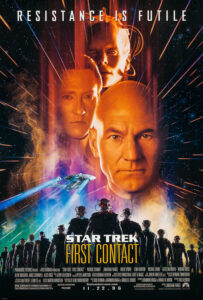 Of the four TNG feature films, the most successful of the quartet was 1996’s STAR TREK: FIRST CONTACT (106 mins., PG-13; Paramount), the one Next-Gen feature film that truly appealed to audiences outside of the die-hard Trekkie fan base. Its mix of exciting action, intriguing story (involving time travel, saving the Earth, and mankind’s first meeting with extraterrestrial life), and an effective villain (The Borg, and specifically Alice Krige’s Borg Queen) managed to exceed box-office expectations and gain crossover appeal in the process. In fact, after a pair of disappointing follow-ups, “First Contact” plays better than ever, despite some minor missteps here and there. Of the four TNG feature films, the most successful of the quartet was 1996’s STAR TREK: FIRST CONTACT (106 mins., PG-13; Paramount), the one Next-Gen feature film that truly appealed to audiences outside of the die-hard Trekkie fan base. Its mix of exciting action, intriguing story (involving time travel, saving the Earth, and mankind’s first meeting with extraterrestrial life), and an effective villain (The Borg, and specifically Alice Krige’s Borg Queen) managed to exceed box-office expectations and gain crossover appeal in the process. In fact, after a pair of disappointing follow-ups, “First Contact” plays better than ever, despite some minor missteps here and there.
Brannon Braga and Ronald D. Moore’s script manages to effectively juggle several story lines with humor, solid action and the best villain this side of Khan. The central plot clicks – the Enterprise travels back in time to stop the Borg from colonizing the Earth, meeting with warp-drive engineer Zefram Cochrane (James Cromwell) in the process – and as the filmmakers note in their commentary tracks, everyone knew that “First Contact” was working right from the get-go. The result is an entertaining and confident film that’s easily the best of the four TNG features, giving its cast members a function and entertaining both casual viewers and Trekkies alike in the process.
Again, the UHD’s increased detail – and really the fact this is a fresh scan in the first place – makes revisiting “First Contact” a joy in Paramount’s 4K set. The Dolby Vision HDR and added detail smokes the older, blurrier master seen on Paramount’s previous Blu-Ray, and the 7.1 Dolby TrueHD sound is robust once again.
Commentaries, featurettes and interviews are all on tap as usual, from talks by director/star Jonathan Frakes to Braga and Moore to a later chat with Damon Lindelof and the general behind-the-scenes doc “First Contact: Production,” which is comprised of six separate featurettes running over an hour.
“The Star Trek: Universe,” meanwhile, offers three additional featurettes, including a 20-minute tribute to Jerry Goldsmith. Featuring vintage comments and footage of Goldsmith at the recording session, working with his son Joel (who scored some of the Borg sequences since there wasn’t enough time for his father to score the entire film), this is a heartfelt tribute to Goldsmith, who returned to the series here for the first time since “Star Trek V: The Final Frontier.” Frakes, Berman, TNG composer Jay Chattaway and others appear to give their recollections of Goldsmith’s wonderful scores and contributions to the Trek franchise. Of particular interest for fans will be Berman’s notes on how he wanted Goldsmith’s “Motion Picture” theme for the “Next Generation” series, how he brought the composer in for “Star Trek: Voyager,” and how much his music added to “First Contact” in particular.
 Despite “First Contact”’s general approval with fans and critics alike, the series’ follow-up was the limp STAR TREK: INSURRECTION (103 mins., 1998, PG), a disappointingly mild adventure that ranks as my least favorite of the “Next Generation” films. Despite “First Contact”’s general approval with fans and critics alike, the series’ follow-up was the limp STAR TREK: INSURRECTION (103 mins., 1998, PG), a disappointingly mild adventure that ranks as my least favorite of the “Next Generation” films.
In Michael Piller’s script, Captain Picard and company protect a race of peace-loving, non-technological types enriched by a fountain-of-youth generated by their native planet’s outer rings, and under attack from both Federation fiend and alien foe (think “Lost Horizon” crossed with “TNG” and you get the picture). Naturally, it wouldn’t be much of an adventure unless someone had to spoil the party, and here the villainy is supplied by F.Murray Abraham and his band of ugly nasties who must have gotten their flesh-expanding skin treatments from the same doctor who worked on Katharine Helmond in “Brazil.” Subplots this time out include Picard’s romance with a lovely member of the planet’s non-combative people (Donna Murphy), Riker’s romance with Troi (though there isn’t much of it), Federation admiral Anthony Zerbe’s questionable relocating of indigenous cultures for his own good (the movie’s political food for thought), and several other plot strands that will evaporate from memory right after the movie is over.
Jonathan Frakes’ direction is sturdy once again but the movie never grabs the viewer and gels. It takes too long to get going, and along the way there are an abundance of extraneous scenes and “cute” sequences that never pay off (from the Gilbert & Sullivan shuttle chase to a young native boy’s fascination with Data and Worf’s onsetting “puberty”). The film feels sluggish and the lack of a thoroughly reprehensible villain is felt right from the start; so much for a movie with a poster slogan that once proclaimed “On December 11, Meet the New Face of Evil!” Abraham is adequate but Piller’s script is more TV-like than cinematic, so don’t be expecting any “Wrath of Khan” here.
That said, “Insurrection” still makes for passable entertainment, but this time it’s mainly for fans only. Jerry Goldsmith’s score is pleasant and in some ways ranks as his finest for the later Trek films, but it’s the story that’s the problem – and in hindsight, marked the beginning of the end for the TNG cast and the original Trek cinematic franchise as we knew it.
Paramount’s Dolby Vision HDR 4K transfer is miles ahead of its weak Blu-Ray transfer and better represents the work of cinematographer Matthew F. Leonetti. Jonathan Frakes and Marina Sirtis provide the commentary on “Insurrection” and there are, as with the previous Blu-Ray, ample featurettes and, more interestingly, numerous deleted scenes including a longer kiss between Patrick Stewart and Donna Murphy, plus test footage of F. Murray Abraham’s original fate in the film.
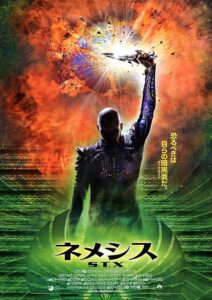 The TNG movie cycle ended with a whimper with STAR TREK: NEMESIS (116 mins., 2002, PG-13). The TNG movie cycle ended with a whimper with STAR TREK: NEMESIS (116 mins., 2002, PG-13).
Unlike “Insurrection,” “Nemesis” was at least a valiant attempt at making a Star Trek movie that you needn’t be a Trekkie to fully appreciate. On paper, John Logan’s script does all the right things: establishes a basic, central conflict with a principal villain (a young Tom Hardy) whose motives you clearly understand, gives the supporting characters something to do (not too easy, as we know from previous Trek movies), and plays off the strengths of Patrick Stewart and Brent Spiner, the cornerstones of the TNG series.
I can only imagine that Logan’s story must have been a great read, but something went amiss on the way to the 23rd century. “Nemesis” is flat when it ought to be thrilling, talky and dull when it should be energetic and interesting – it’s a movie that keeps teetering on the edge of being something more, but it never gets there, perhaps the result of Stuart Baird’s involvement, as the ace editor proved to be little more than a workmanlike director of feature films (this movie falling right in line with his only other two directorial credits: “Executive Decision” and the “Fugitive” sequel “U.S. Marshals”).
“Nemesis” was the only TNG feature to fare well on Blu-Ray so this UHD Dolby Vision enhancement probably presents the smallest gap between it and its 1080p counterpart – though it still benefits from Dolby Vision HDR. The 7.1 TrueHD sound again is satisfying and extras include deleted scenes and three commentaries along with the requisite amount of behind-the-scenes featurettes – albeit with less candor than you might hope for.
Paramount has sweetened this eight-disc set with remastered Blu-Rays and Digital HD codes. Check my original DVD reviews for more specific information on the featurettes included within, but they seem to be by and large completely inclusive of previous releases in terms of extras (sans the Blu-Ray box’s “Star Trek: Evolutions” bonus disc).
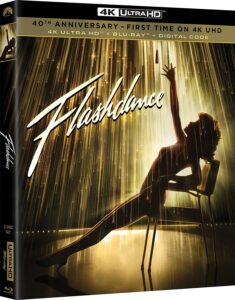 Debuting April 11th on 4K UHD is FLASHDANCE (94 mins., 1983, R; Paramount), the silly box-office smash from ‘83. Its simple rags-to-riches tale of an 18-year-old (Jennifer Beals) who welds by day and dances at night — so she can make it as a legitimate ballet dancer — is basically “Cinderella in Pittsburgh,” complete with a knight in shining armor (Michael Nouri), who here happens to be the boss of the construction company she works at. Debuting April 11th on 4K UHD is FLASHDANCE (94 mins., 1983, R; Paramount), the silly box-office smash from ‘83. Its simple rags-to-riches tale of an 18-year-old (Jennifer Beals) who welds by day and dances at night — so she can make it as a legitimate ballet dancer — is basically “Cinderella in Pittsburgh,” complete with a knight in shining armor (Michael Nouri), who here happens to be the boss of the construction company she works at.
All you have to do is take a look at the individuals who made “Flashdance” to know what the movie is all about. It was directed by Adrian Lyne, produced by Don Simpson and Jerry Bruckheimer, co-written by Joe Eszterhas, and scored by Giorgio Moroder (with “Sylvestor” Levay receiving credit for arranging and conducting Moroder’s compositions). The soundtrack features plenty of classic ’80s songs (including the Oscar-winning Irene Cara title track) and offers slick and satisfying entertainment so long as you aren’t looking for much of a story.
Paramount’s new 4K remaster of “Flashdance” is more impressive here with Dolby Vision HDR than it was in its 2020 “Paramount Presents” package, with that platter being reprieved here as the accompanying Blu-Ray disc. It features a brief new interview with Lyne included on the supplemental end, along with two featurettes from the older release (though as with the other Paramount Presents discs, a number of extras from the previous releases was regrettably excised).
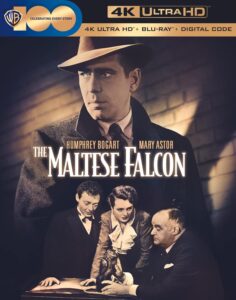 New 4K Catalog From Warner New 4K Catalog From Warner
Warner Home Video has a number of 4K UHD catalog premieres due out throughout the year, with a trio of studio classics heading to retailers throughout April.
The success of the 1955 drama “East of Eden” lead Warner Bros. to cast rising star James Dean in a pair of films the following year: George Stevens’ “Giant” and REBEL WITHOUT A CAUSE (111 mins., 1956, PG-13), which is obviously Dean’s signature role. The ill-fated young star plays a disillusioned youth who butts heads with school bullies and his confused parents in what was the most powerful of his trio of films for Warner. Natalie Wood and Sal Mineo likewise shine in supporting performances but it’s the filmmaking of director Nicholas Ray – captured in full 2.55 widescreen – that really heightens this teenage drama, giving the movie a powerful visual sheen that’s as palpable as the film’s dramatic tension.
Warner’s 4K UHD offers a new Dolby Atmos soundtrack (along with the original 2.0 DTS MA sound) and HDR10 enhanced transfer; this is a great looking disc capturing the full widescreen image of the film and preserving its 50’s aesthetic, capped with Leonard Rosenman’s score. Supplements include a commentary by Dean historian Douglas L. Rathgeb and three documentaries, the trailer, additional scenes (minus sound), the trailer, Blu-Ray, and a Digital HD copy.
John Huston’s THE MALTESE FALCON (100 mins., 1941) needs little introduction for film noir buffs – and Golden Age fans in general. This seminal adaptation of Dashiell Hammett’s novel from screenwriter-director Huston boasts Humphrey Bogart as Sam Spade as he attempts to find out why a motley assortment of characters want their hands on a jewel-adorned falcon. Indelible support from Mary Astor, Sydney Greenstreet and Peter Lorre make for a must-view that has been enhanced with an HDR10 UHD transfer that’s an appreciable upgrade on its prior Warner Blu-Ray edition, thanks to this high-contrast, detailed 4K scan (1.37 B&W, mono). Extras include a commentary by Eric Lax and extras carried over from the Blu-Ray, including featurettes, short subjects, and assorted radio adaptations (a Digital HD code and Blu-Ray are also on-tap).
Also new from Warner is COOL HAND LUKE (126 mins., 1967, GP), one of Paul Newman’s “message movies” with the star as the title noncomformist – a WWII vet whose drunken wanderings during the 1950s lands him in a small Florida prison. There, he butts heads with a warden (Strother Martin) in a potent anti-establishment piece from writers Donn Pearce and Frank R. Pierson. One of Newman’s most memorable performances, this widescreen picture receives another superlative 4K scan here from Warner (2.35), HDR10 doing the vivid lensing of the film justice along with Lalo Schifrin’s score via a crisp mono soundtrack. Extras include Eric Lax’s commentary, a Making Of, the trailer, Blu-Ray and Digital HD copy.
 New on Blu-Ray New on Blu-Ray
DAWSON’S CREEK: The Complete Series Blu-Ray (92 hours, 1998-2003; Mill Creek): In the late ‘90s Kevin Williamson created a teen angst drama that managed to strike the right balance between the soap opera melodramatics of “90210” and the more “reality” driven edge of “My So-Called Life.”
When it initially premiered on the then-fledgling WB network in 1998, “Dawson’s Creek” also had controversy written all over it: one of the characters was supposed to have an affair with one of his teachers, while sex was supposed to have been a freely-discussed topic. Parents wondered if the show would be suitable for youngsters, while the network issued various “warnings” to its targeted demographic about the subject matter.
That controversy, though, soon died out as it became apparent how sweet and innocuous “Dawson’s Creek” actually was. Williamson’s often smartly-written show examined the life of a Cape Cod-ish teen named Dawson Leery (James Van Der Beek) who wants to be the next Steven Spielberg, his best-friend/soulmate Joey Potter (Katie Holmes), Jen, the new girl in town with a troubled past (Michelle Williams), and their ever-lovable, underachieving pal Pacey Whitter (Joshua Jackson). “Capeside” is your quintessential little New England coastal town, and while the show was actually filmed on location in North Carolina, the program did an excellent job capturing the authentic feel of a place far removed from shows like 90210, with more level-headed kids trying to live out their aspirations and move forward with their lives.
The interplay between the characters and the show’s writing — especially in its first season — are what made “Dawson’s Creek” a big hit for the WB, with the program being constantly aware of its genre and sometimes mocking it. At the same time, the show indulged in all the trappings of a good prime time teen drama: scandals, dating, sex, family relationships, personal responsibility, and all the inherent problems in growing up were deftly exploited by the producers, who brought in filmmakers like Steve Miner to help establish the program’s look and feel. And through it all, the core ensemble cast remained an attractive, appealing bunch to watch each week.
What more can I say? I admit it: I watched “Creek” almost from start to finish, and lived through its uneven subsequent seasons when the cast tried to hang together despite some sub-par plots — problems, though, that any TV show with a five-year run often go through. “Dawson’s Creek” was an unabashed guilty pleasure for a lot of viewers, not just teens but anyone old enough to have watched the John Hughes comedies from the ’80s. Its myriad of genre conventions were complimented particularly in its first few seasons by characters you cared about and situations most everyone lived through at one time or another.
Whether or not you enjoyed those times can say a lot about one’s tolerance for “Dawson’s Creek,” but Mill Creek has collected all 127 episodes here on Blu-Ray with 1.78 transfers and 5.1 DTS MA soundtracks. It’s a competent a/v package and the label has done a nice job with extras including new interviews/crew featurettes; commentaries on select episodes; the Entertainment Weekly 20th Anniversary Reunion; and alternate scenes/ending to the original pilot presentation.
If you’re still reading this review, chances are that you too are a closet fan of “Dawson’s Creek,” in which case this Blu-Ray edition will bring back some fond memories. Even when it’s bad, it’s still good, and the program’s solid, five-year run proved that there are plenty of Capeside addicts out there who will enjoy having the complete series on disc, to enjoy again at their leisure.
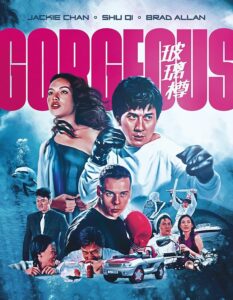 Coming later this month from Mill Creek, THE CENTER SEAT: 55 YEARS OF STAR TREK (9 hours, 2021) is an excellent documentary from director Brian Volk-Weiss that charts the history of Gene Roddenberry’s franchise. Fans will have likely heard many of these anecdotes previously but it’s nevertheless a breezy, compelling overview with fresh cast/crew/historian conversations, recounting the Desliu days through the franchise’s more recent spinoffs. Uncut, long-form interviews with Leonard Nimoy, Nichelle Nichols and Kirstie Alley are also on-hand in Mill Creek’s four-disc DVD set (16:9), the production itself narrated by Gates McFadden. Coming later this month from Mill Creek, THE CENTER SEAT: 55 YEARS OF STAR TREK (9 hours, 2021) is an excellent documentary from director Brian Volk-Weiss that charts the history of Gene Roddenberry’s franchise. Fans will have likely heard many of these anecdotes previously but it’s nevertheless a breezy, compelling overview with fresh cast/crew/historian conversations, recounting the Desliu days through the franchise’s more recent spinoffs. Uncut, long-form interviews with Leonard Nimoy, Nichelle Nichols and Kirstie Alley are also on-hand in Mill Creek’s four-disc DVD set (16:9), the production itself narrated by Gates McFadden.
GORGEOUS Blu-Ray (120/99 mins., 1999, PG-13; 88 Films): After finally achieving widespread success at the U.S. box-office with the likes of “Rumble in the Bronx” and “Shanghai Noon,” Jackie Chan found himself subsequently splitting time between American studio films and pictures aimed more at his home Asian market. Case in point is the fascinating and quite entertaining “Gorgeous,” initially conceived as a straight rom-com but turned into more of a light action flick once Chan became associated with its story of a businessman who falls in love with the beautiful Shu Qi, only to get her mixed up in his rivalry with another HK businessman whom he’s known since childhood.
Chan also produced and was heavily involved in the development of “Gorgeous” which is an awful lot of fun, having been produced at a prime time in Chan’s international stardom. The original cut is a bit long at 120 minutes, making its “international version” recut actually a bit tighter and more satisfying having been shorn of 20 minutes — both are present here in 88 Films’ terrific Blu-Ray (2.35), each from 2K transfers from original film materials. 5.1 Cantonese and English dubs (on the international version) are on-hand plus two historian commentaries on the longer version, along with a commentary by Jackie Chan on the international edit. In addition to booklet notes and a foldout poster, 88’s Blu-Ray comes with music videos, an interview with director Vincent Kok and a conversation with Andy Cheng on co-star Brad Allen.
 Coming April 11th from Cult Epics is a limited-edition Blu-Ray of director Martin Koolhoven’s AMNESIA (89 mins., 2001), the story of a photographer (Fedja van Huet) who uncovers family secrets he soon wishes remained buried. “Game of Thrones”‘ Carice van Houten co-stars in this well-regarded if seldom discussed thriller which is presented here in a new 4K scan (1.66) from the OCN with plenty of extras in Cult Epics’ Blu-Ray. These include commentary and an introduction from the director alongside van Huet; a long interview between Koolhoven and van Houten; a vintage Making Of; the trailer; and segment with Van Houten from 2001. A bonus Blu-Ray is also included sporting two earlier TV movies by the director: “Suzy Q” and “Dark Light.” Coming April 11th from Cult Epics is a limited-edition Blu-Ray of director Martin Koolhoven’s AMNESIA (89 mins., 2001), the story of a photographer (Fedja van Huet) who uncovers family secrets he soon wishes remained buried. “Game of Thrones”‘ Carice van Houten co-stars in this well-regarded if seldom discussed thriller which is presented here in a new 4K scan (1.66) from the OCN with plenty of extras in Cult Epics’ Blu-Ray. These include commentary and an introduction from the director alongside van Huet; a long interview between Koolhoven and van Houten; a vintage Making Of; the trailer; and segment with Van Houten from 2001. A bonus Blu-Ray is also included sporting two earlier TV movies by the director: “Suzy Q” and “Dark Light.”
SOUTH PARK: 25th Season Blu-Ray (134 mins., 2022; Paramount): Now that COVID is over it seems like Trey Parker and Matt Stone are back to turning out more conventional episodes of their long-running animated comedy. This brief (just six episodes) run from February of last year includes a couple of funny segments, including “The Big Fix,” wherein “Token”’s name origin is cleared up. Scattershot laughs and some protracted storylines make for a mixed bag, par for the course with recent seasons of the show. Paramount’s Blu-Ray (5.1 Dolby TrueHD, 1.78) is out this week.
PLANE Blu-Ray (107 mins., 2023, R; Lionsgate): Gerard Butler is back for more action shenanigans, this time as an intrepid pilot who saves the day after his plane is struck by lightning — only to have his passengers taken hostage after an emergency landing on a revolution-torn island. He teams up with Mike Colter’s accused murderer in a respectable genre outing that knows how to get the job done under the direction of Jean_Francois Richet. Lionsgate’s now-available Blu-Ray (2.39, Dolby Atmos) sports three featurettes, the trailer, and a Digital HD copy.
NEXT TIME: Kino Lorber wrap! Vinegar Syndrome and more! Until then, don’t forget to drop in on the official Aisle Seat Message Boards and direct any emails to our email address. Cheers everyone!
| 




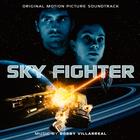








 George C. Scott stars in the film as Lt. Kinderman, the Washington, D.C. cop played by Lee J. Cobb in the 1973 William Friedkin classic. Here tasked with solving a series of grizzly murders carrying an increasingly religious connotation, Kinderman’s investigation includes both the death of his beloved friend Father Dyer (Ed Flanders, in funny scenes that make you wish he and Scott had more screen time together) and the strange presence of “Patient X” (Brad Dourif) – a hospital inmate who claims he’s the “Gemini Killer.” The only problem is that psycho died some 15 years before, on the same night the demon claimed the life of Father Karras (Jason Miller) in the Regan MacNeil exorcism…
George C. Scott stars in the film as Lt. Kinderman, the Washington, D.C. cop played by Lee J. Cobb in the 1973 William Friedkin classic. Here tasked with solving a series of grizzly murders carrying an increasingly religious connotation, Kinderman’s investigation includes both the death of his beloved friend Father Dyer (Ed Flanders, in funny scenes that make you wish he and Scott had more screen time together) and the strange presence of “Patient X” (Brad Dourif) – a hospital inmate who claims he’s the “Gemini Killer.” The only problem is that psycho died some 15 years before, on the same night the demon claimed the life of Father Karras (Jason Miller) in the Regan MacNeil exorcism… Shout’s 4K UHD carries over its 2016 supplemental package, which boasted then-new interviews with surviving cast/crew members, including Brad Dourif, producer Carter DeHaven, production designer Leslie Dilley, loads of make-up artists, bit players in the supporting cast, and composer Barry DeVorzon among others. Editor Todd Ramsay relays several fascinating tidbits, including the revelation that he knew he was sitting with Blatty for the final time when he unspooled his edit of the film – to negative reaction from seemingly everyone involved, except Dourif, who thinks his performance was much better in Blatty’s version. Meanwhile, DeVorzon’s talk implies studio brass didn’t like his score either – with even Carter DeHaven seemingly unenthusiastic over his initial hiring – which is no shock since there’s less music in the film than there is sound design (though in that regard, DeVorzon’s work was ahead of its time).
Shout’s 4K UHD carries over its 2016 supplemental package, which boasted then-new interviews with surviving cast/crew members, including Brad Dourif, producer Carter DeHaven, production designer Leslie Dilley, loads of make-up artists, bit players in the supporting cast, and composer Barry DeVorzon among others. Editor Todd Ramsay relays several fascinating tidbits, including the revelation that he knew he was sitting with Blatty for the final time when he unspooled his edit of the film – to negative reaction from seemingly everyone involved, except Dourif, who thinks his performance was much better in Blatty’s version. Meanwhile, DeVorzon’s talk implies studio brass didn’t like his score either – with even Carter DeHaven seemingly unenthusiastic over his initial hiring – which is no shock since there’s less music in the film than there is sound design (though in that regard, DeVorzon’s work was ahead of its time). Also New on 4K UHD
Also New on 4K UHD What a shame, too, since the movie has some excellent moments, sparkling cinematography by John A. Alonzo, and an excellent score by Dennis McCarthy which I felt was unfairly maligned by some fans upon its initial release. Years later, McCarthy’s score has held up even better than I thought it would, with the composer offering a fresh slate of themes and a more majestic, ethereal sort of score than the later TNG films contained.
What a shame, too, since the movie has some excellent moments, sparkling cinematography by John A. Alonzo, and an excellent score by Dennis McCarthy which I felt was unfairly maligned by some fans upon its initial release. Years later, McCarthy’s score has held up even better than I thought it would, with the composer offering a fresh slate of themes and a more majestic, ethereal sort of score than the later TNG films contained. Of the four TNG feature films, the most successful of the quartet was 1996’s
Of the four TNG feature films, the most successful of the quartet was 1996’s Despite “First Contact”’s general approval with fans and critics alike, the series’ follow-up was the limp
Despite “First Contact”’s general approval with fans and critics alike, the series’ follow-up was the limp The TNG movie cycle ended with a whimper with
The TNG movie cycle ended with a whimper with Debuting April 11
Debuting April 11 New 4K Catalog From Warner
New 4K Catalog From Warner New on Blu-Ray
New on Blu-Ray
 Coming April 11th from Cult Epics is a limited-edition Blu-Ray of director Martin Koolhoven’s
Coming April 11th from Cult Epics is a limited-edition Blu-Ray of director Martin Koolhoven’s
